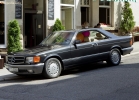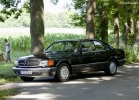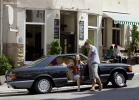Test drive Mercedes Benz S-class W126 1979-1991 sedan
$3000
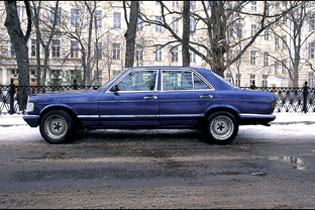 Favorite car of car deles, distillery and ambassadors. The former love her for reliability, the latter for comfort, others for solidity. All together is Mercedes W126.
Favorite car of car deles, distillery and ambassadors. The former love her for reliability, the latter for comfort, others for solidity. All together is Mercedes W126. second mobileists are supposed to have beliefs. So that there was something to defend. Some are sure that the car must certainly be big. Others believe that before cars were produced stronger and more reliable than modern ones. Still others are ready to hoarsely argue that any good car, if called Mercedes. All these points of view corresponds to Mercedes-Benz W126.
Mercedes-Benz with a body W126 appeared in the fall of 1979. The last democrat of the representative S-class. Cars with a manual box, without air conditioning, ABS and electric windows are not uncommon if we are talking about the 126s of the first half of the 80s. But the requirements changed, and the 126th beginning of the 90s is, as a rule, all conceivable options from airbags to the anti-industrial system. Hence the tenfold spread of prices for used cars.
BODY. Someone will call him classic, someone old-fashioned. One way or another, this car is absolutely not interested in either young people or bandits. In Russia, ambassadors of African states are riding the W126 (the country's budget is comparable to the cost of the new S-class car), the distillery (they estimated the advantages of free landing) and car delesy (they do not like to repair their cars, since they do not pay for it).
The 126th were produced in three bodies: a five-meter sedan (designation S and SE), an elongated sedan (15 cm, due to the rear doors, the last letter L in the SEL index) and the coupe (the last letter with SEC). All cars are distinguished by enviable strength. Even at the very shaggy of the 126th door, they close softly, as in the German refrigerator. The through corrosion of the bottom will not wait. The rust must be sought on the edges of the wings (it is often camouflaged with decorative lining-liners), on the lid of the trunk and under its inner skin.
Lovely rust, cabbage, does not appear very soon: the paint is excellent. On the other hand, the 126th younger seven years in nature does not exist. The legend that the new 126th can be ordered now for very large grandmothers is not true: you will not order any grandmas, in any case, they say in the Moscow representative office of the concern. The last car left the plant in 1993. It was the 126th compartment. A handsome man with a star on a radiator grille. It is rare: the coupe in good condition is torn with hands even at cunning Mercedes web conferences. On average, one or two coupe falls on ten sedans. The main problem is in body details. For example, on the compartment an aluminum hood. The hood is consumable. From disassembly, rare. And a new one, on order, costs from $ 250 (left, iron) to $ 2300 (at the official dealer). For comparison: for a used hood, $ 50100 is asked for a sedan (a new dealer has $ 950).
Claims to the salon of the 126th is just a nit-picking: ventilation does not cope with fogging of the glasses of the rear doors.
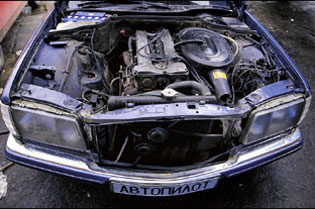 Engines. There is a huge selection, except for diesel engines. Rather, there were diesel engines (3 and 3.5 liters), but few, and they went mainly to the American market.
Engines. There is a huge selection, except for diesel engines. Rather, there were diesel engines (3 and 3.5 liters), but few, and they went mainly to the American market. The most common engine of the 110th, with a volume of 2.8 liters. It was produced both with a carburetor (designation of a single carburetor model based on the 126th body of 280S), and with an injector (280 SE). The 110th engine, in-line six, is considered the most unsuccessful choice of vibrant (up to 18 liters) and forever snotty. The oil flows from under the gasket of the valve cover, as well as from the rear crankshaft. The sealing there is a stuffed (as on the Volga), so it is better not to pour synthetic oil. However, it is not worth saving in oil. Poorly oil or irregular replacement leads to the fact that the timing chain cuts the tensioner shoe, bite into metal, breaks, valves are found with pistons, and the owner with repair, dollars for at least at least.
The 110th in 1985 was replaced by the 103rd engine (volume 2.6 and 3 liters, also in-line six). It is structurally easier (one camshaft, not two), quieter and more economical. However, the 103rd motor suffers from poor oil: hydraulic compensators freeze, as a result of which camshaft cams are growing. Repair from $ 200.
The second type of engines V-shaped eights: 3.8 and 4.2 l (116th motor); 5.0 liters and 5.6 l (117th). They are more difficult to maintain. There are more people who want to take up the repair than those who can bring it to the end. Consider when buying: on engines 2.6, 2.8 and 3.0 liters of specialists are not an example anymore.
The largest engine installed on the 126th body has a volume of 5.6 liters, 300 liters. With. (produced since 1985). Despite eight cylinders, it is very difficult to achieve even at idle (the engine is subtorm), and the fuel consumption in the city reaches 25 liters.
TRANSMISSION. On low -commissures 260, 280, 300 were both mechanical and automatic boxes. The rest is only an automatic. It is better to check the machine before buying. When the drive and released brake pedal is turned on, the car should roll, and the gear shift in motion occurs without jerks. The twitching box can last more than one year, but in any case, it greatly reduces the resource of the rear axle gearbox. However, its price (referring to the unit used) $ 50 removes the issue from the agenda.
The automatic box on the 126th has a rare quality allows you to start the car from the pushing, in tow.
It is interesting that the fuel consumption by car with automatic transmission and engine is 2.6 higher than with 3-liter: all due to the fact that the lack of power is compensated by constant gas.
Chassis. Very strong. Not like Rup-Sokok, the mechanics are said to the offense of the 140th body, the heir to the 126th. The back is almost eternal, one to one with a common 123rd body, which facilitates the search for both new and used spare parts (by the way, it is also suitable for the front). The most expensive part of the suspension is supporting hinges in the front. There are 150 thousand, but cost $ 70250 apiece (replacing $ 120 per pair). The condition of the hinges can be found out only when all other parts of the pendants are working. When hitting the curb, a characteristic sound is heard.
Brakes. Until 1985, ABS was an option, later installed in standard configuration. When buying, pay attention to the calipers of the rear brakes. They come in two types: rigidly fixed (located closer to the trunk) and floating (closer to the driver). The second option is worse, as it requires regular replacement of the bearing (up to $ 100 with work, in one side). The front brakes have a different trouble: from long -term parking on the mirror of the brake cylinders, sores appear, which is why cuffs are torn and the liquid leaves. Repair from $ 80 for each side.
Results. Most of the Mersedes-Benz W126 problems are due to the fact that in any case the car will get the old one. Despite this, it is ideal for those who put their own comfort above the opinions of fashionistas or simply want to feel like a German chancellor or Arab Sheikh for very moderate money. Let it be late for 20 years
Text Stepan Shakurin, photo Alexey Ilyin
A source: "Autopilot"

